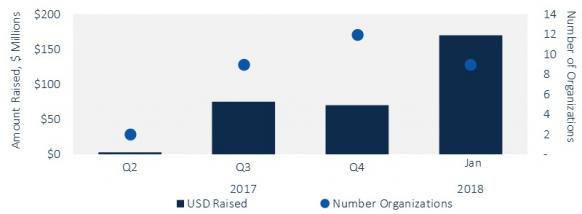Utility-backed blockchain platform set for full launch in early 2019
The Energy Web Foundation's open-source blockchain platform aims to cut transaction costs and create new market opportunities in areas such as certificate trading, plant maintenance and demand response, project directors said.

Related Articles
On February 22, S&P Global Platts announced it had deployed a proprietary, secure Blockchain network for reporting oil storage data in the United Arab Emirates (UAE), representing one of the first live launches of commercial blockchain technology in the energy sector.
Blockchain's distributed ledger system eliminates the need for intermediaries to create centralized trust and reduces transaction costs. Security is assured as data is stored across multiple devices and not changeable by any one person, according to proponents.
In the electricity sector, non-profit group Energy Web Foundation (EWF) will soon bring to market an open-source blockchain platform designed to increase efficiency and widen market access. Based in Switzerland, EWF was created in 2017 by the Rocky Mountain Institute and IT firm Grid Singularity.
To date, some 38 companies have joined EWF's blockchain project, including power utilities, technology providers and venture capital firms in the U.S., Europe, Asia and Australia.
EWF will demonstrate the commercial capabilities of its platform by building the first applications. Based on market value and potential impact, EWF has shortlisted five priority applications of blockchain software in the energy sector: Certificate of origin markets, utility billing systems, demand response programs, transactive energy systems and electric vehicle charging.
Blockchain applications in these areas could generate billions of dollars of cost savings for power generators, power purchasers, and regulators, Doug Miller, development manager at EWF, told New Energy Update.
“For example, our research suggests that the market opportunity for Certificate of origin trading is at least $1 billion globally based on reductions in transaction and administrative costs," he said.
EWF is currently building out an ecosystem of users, application developers and infrastructure providers for its platform.
The project team launched an alpha version of its platform in November 2017 and plans to launch a beta version in April, Amy Westervelt, EWF’s Program Coordinator, told a New Energy Update webinar on February 27.
"Our roadmap has us going live with the full commercial version of the Energy Web Foundation platform in spring 2019," she said.
Proof of authority
Over $300 million was invested in blockchain in the energy industry between April 2017 and January 2018, GTM Research said in a report published earlier this month.
A surge in funding was recorded in January and there are currently 122 groups involved in blockchain technology in the energy sector and 40 deployed projects, GTM Research said.
Funds raised for blockchain in energy
(Click image to enlarge)
Source: GTM Research (March 2018).
EWF’s blockchain platform is designed to support innovations in the energy sector and provide security measures which meet the requirements of energy companies and regulators.
Public access means the platform can tap a large developer base and maximize scalability, a key requirement of energy sector participants.
Importantly, the platform uses a “proof of authority” mechanism in which ratified companies such as utilities serve as authorities to approve blocks.
These authorities pay membership fees to EWF and therefore have a strong vested interest in acting ethically within the system, Westervelt said.
"In addition this structure is attractive to regulators because they can know exactly who is approving the transaction history embedded in the chain," she said.
Certificates of origin
EWF is currently developing an application for the certificate of origin markets, which will track generated renewable energy and associated carbon offsets on a single platform used across multiple regions. Participants in the project include European energy companies Engie and, Statoil, U.S. power utility Exelon, Singapore's SP Group and Thailand's PTT.
Certificate of origin markets provide renewable generators with additional revenue sources and help companies and policymakers provide proof of renewables purchases and output to meet carbon reduction targets. EWF's application aims to expand the certificate of origin market and unlock the market for small and medium-sized renewable energy generators.
Today's certificate of origin market lacks transparency and data reporting is time-consuming, typically done on a yearly basis, Miller said.
"It's not easy to navigate...there is a whole bunch of different process steps involving a large number of stakeholders," he said.
Through the blockchain platform, generation and location data could be uploaded hourly. Kilowatt-hours of generation data would be tagged with data and available to purchase. This would provide more granularity than today's convention of traded megawatt-hour units, unlocking the market for small and medium-sized renewable energy generators, Miller said.
Agreements could be made bilaterally without the need of a broker and the platform's tracking of generation, carbon impact and demand matches should provide buyers with a greater choice, Miller said. The open source framework would also enable applications to adjust to different market regulations and requirements.
"By providing a common platform...We think this will simplify the process, especially for internationals," he said.
Smart contracts
EWF believes its blockchain platform could also raise efficiencies in demand response measures and electric vehicle use, through smart contracting and real-time payment capability.
Blockchain and smart contracts could also impact maintenance practices.
For example, a device installed on a power line could provide data which triggers smart contracts and notifies service providers to fix the issue, supporting payments in real-time, Westervelt said.
"This eliminates the need to go through several different intermediaries who convey information and orders to the next person in the chain," she said.
Another potential use for blockchain technology is to reduce the cost of aggregating renewable energy generation for virtual power plants (VPPs)
"In the past, the organization and management of VPPs of different sizes was complex and costly. Blockchain technology has the potential to make this process more efficient," PwC consultancy said in a report on blockchain in the energy industry, published in July 2017.
"On a lower level the VPPs can-- based on smart contracts-- optimize themselves to a certain degree, and if the balance of the current optimization level is not sufficient, then optimization against the next higher level (e.g distribution grid) can be done via blockchain very efficiently as well," PwC said.
Supply chain applications are also expected to provide significant value, for example in guarantee of origin applications. Supply chain applications may be harder to build than energy or certificate trading applications due to the transferral of physical assets rather than digital assets, Miller said.
Growing power
An industry drive towards the "best possible" block chain technology should allow performance increases at low marginal cost, Miller told New Energy Update.
In the coming years, the introduction of new technologies could allow "the interconnection of multiple chains or the settlement of transactions off-chain, which will increase the performance of blockchains to completely new heights," Miller said.
New blockchain concepts such as parallel chains will significantly increase processing capacity, he said.
These improvements could support applications such as decentralized grid applications, which could transform the distribution of energy supply.
For example, EWF and Grid Singularity have developed a new market design for the energy grid, where the energy is traded in a decentralized way and balancing areas can be defined as small as a single electricity meter, Miller said.
"If we envision a future where that reality is possible, we need to provide an infrastructure that can withstand millions and potentially billions of Internet of Things (IoT) devices writing transactions in the blockchain," he said.
According to PwC, the IoT can unleash the real potential of blockchain.
“This machine to machine communication could be managed with blockchain(s), leveraging its benefits, such as immutability, speed and automatization. It will be interesting to see, how these will create even more use cases in future," PwC said in its report.
New Energy Update

